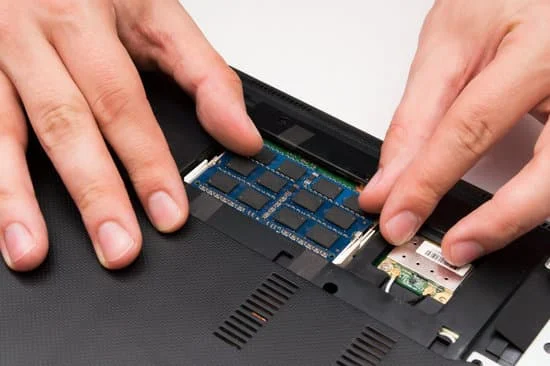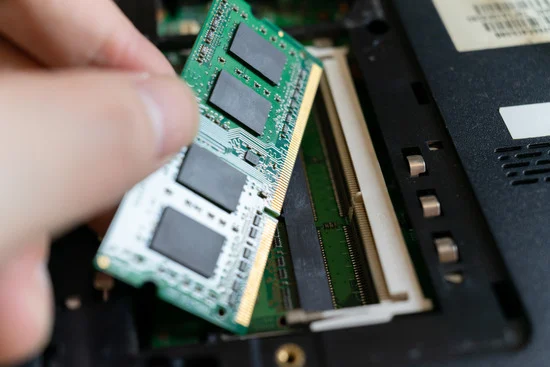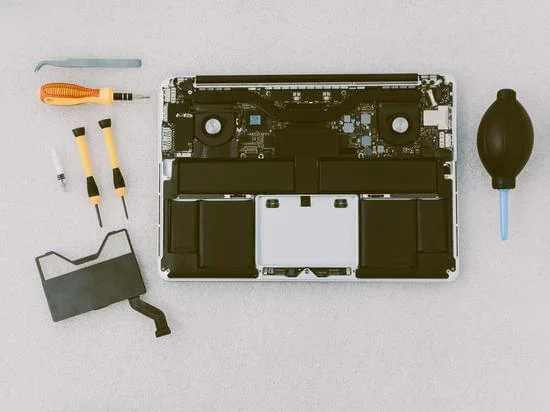Laptop RAM Upgrade
Laptops are powerful tools, but like all machines, they tend to lose their edge over time. Whether you’re a gamer, a designer, or just someone who uses their laptop for everyday tasks, you might notice a slowdown in performance. While there might be many potential causes for this, one of the most common culprits is the laptop’s RAM.
However, a laptop RAM upgrade can dramatically boost your device’s performance. In this blog, we’ll discuss why upgrading your RAM is a game-changer, how to go about it, and what benefits you can expect from this simple yet effective upgrade.
Why RAM Matters
When you use a laptop, the processor pulls data from the RAM to perform tasks like running software, browsing the internet, or playing games. However, when your RAM is full, your processor has to rely on your laptop’s hard drive or SSD, which is much slower than RAM. This can result in lag, slow load times, and overall sluggishness.
In simple terms, a laptop RAM upgrade provides more space for your laptop’s processor to work faster and more efficiently.

Signs You Need a Laptop RAM Upgrade
Here are some signs that indicate your laptop could benefit from additional RAM:
1. Slow Performance During Multitasking
If your laptop struggles to perform multiple tasks simultaneously—like having several browser tabs open, running a video conference, and using a word processor—it’s likely because your RAM is maxed out. With limited RAM, your laptop can’t handle multiple processes effectively, which leads to lag and performance dips.
2. Frequent Freezing or Lag
You’ve probably experienced your laptop freezing or stuttering while running applications. This happens when your laptop runs out of RAM and starts using the hard drive as temporary memory, which is much slower. A laptop RAM upgrade can fix this issue by giving your laptop enough memory to perform tasks smoothly.
3. Difficulty Running Memory-Intensive Applications
Running demanding software like video editors, graphic design programs, or even modern games can push your laptop to its limits. If your laptop crashes or becomes unresponsive while using such applications, your current RAM capacity might not be enough to handle the load.
4. Long Boot Times
If your laptop takes longer than usual to boot up, the problem could be insufficient RAM. When your laptop doesn’t have enough memory to load all the processes quickly, it delays the startup time. A RAM upgrade could solve this problem and reduce boot times.
How to Upgrade Your Laptop RAM
Here’s a step-by-step guide to help you through the process.
1. Check Your Laptop’s RAM Specifications
Before purchasing additional RAM, you need to know how much memory your laptop currently has and how much it can handle. You can check the current RAM specifications by looking up your laptop model’s manual or using tools like Task Manager (on Windows) or About This Mac (on macOS) to see how much RAM is installed.
Additionally, make sure to check the maximum RAM your laptop supports. Some laptops have specific limitations on how much RAM they can handle, so it’s important to know that your laptop can support the upgrade you’re planning.
2. Purchase Compatible RAM
Once you know your laptop’s RAM specifications, you can purchase the right RAM sticks. Be sure to match the speed, size, and type of RAM (DDR3, DDR4, etc.) with your laptop’s requirements. Not all RAM modules are compatible with all laptops, so ensure compatibility by checking the specifications carefully.
3. Prepare Your Laptop
Before opening your laptop, turn it off completely and disconnect it from any power sources. Also, remove any external devices like USB drives or external monitors. It’s also a good idea to wear an anti-static wristband to prevent any static electricity from damaging your laptop’s internal components.

4. Open the Laptop’s RAM Slot
Most laptops have a panel on the underside that gives you access to the RAM slots. You may need a small screwdriver to open the panel. Once inside, you’ll see the RAM slots where the memory modules are installed. Some laptops have a single slot, while others may have two or more.
5. Install the New RAM
Gently remove the existing RAM (if you’re upgrading) by pushing the clips on the sides. Place the new RAM module into the slot at a 45-degree angle, ensuring the notches align with the slot. Press down gently until the RAM clicks into place and the clips secure it.
6. Close the Laptop and Test
Once the new RAM is installed, carefully reassemble your laptop, ensuring everything is secure. Afterwards, turn your laptop back on and check the system information to make sure the new RAM is recognized. You can do this by checking the Task Manager or About This Mac, where you should see the updated RAM information.
How Laptop World Can Help With Your Laptop RAM Upgrade
If you’re considering a laptop RAM upgrade but aren’t confident doing it yourself, Laptop World is here to help!
1. Expert Guidance on RAM Compatibility
At Laptop World, our knowledgeable staff will provide expert guidance to help you select the best RAM for your device. We’ll review your laptop’s requirements and recommend the ideal upgrade.
2. A Wide Selection of Compatible RAM Modules
We offer a wide range of RAM options from trusted brands like Kingston, Corsair, Crucial, etc. Our extensive inventory ensures that you’ll find the perfect fit for your device.
3. Post-Upgrade Performance Testing
We conduct thorough performance tests to ensure that your laptop is running at peak performance. We check things like boot times, application loading speeds, and overall system responsiveness to make sure you’re getting the most out of your new RAM.
4. Affordable and Transparent Pricing
We believe in providing value to our customers, and that means offering fair pricing for our RAM upgrade services. You’ll receive an upfront, transparent breakdown of costs for both the RAM and installation. There are no hidden fees, and you can rest assured that you’re getting quality components and professional service at a competitive price.

Final Thoughts
If you’re noticing sluggish performance, difficulty multitasking, or struggles with memory-intensive applications, a laptop RAM upgrade is one of the best ways to give your laptop new life.
However, if upgrading your laptop’s RAM seems like a task you’d rather leave to the professionals, Laptop World is here to help. Let us handle the technical details while you sit back and enjoy a faster, more responsive laptop. Come visit us today.
FAQs
1. Can I add more RAM to my laptop?
Yes, most laptops allow you to add more RAM, provided there are available slots, or the existing RAM can be replaced with a higher capacity module. To ensure compatibility, check your laptop’s specifications for supported RAM size and type before upgrading.
2. Can I upgrade my 8GB RAM to 16GB in laptop?
Yes, you can upgrade from 8GB to 16GB of RAM, as long as your laptop supports 16GB of RAM. Be sure to check your laptop’s manual or system specifications for the maximum supported RAM and ensure the new RAM is compatible in terms of type and speed.
3. Is upgrading RAM worth it for a laptop?
Upgrading RAM is often worth it, especially if you use memory-intensive applications or multitask heavily. More RAM allows for smoother performance, faster load times, and better multitasking. It’s a relatively cost-effective upgrade compared to other hardware changes like a new processor or laptop.
4. Which is better RAM or SSD?
Both RAM and SSD serve different functions and are critical for overall laptop performance. RAM helps with fast access to active data, improving multitasking and speed. An SSD, on the other hand, improves boot times, file access speed, and overall system responsiveness.
